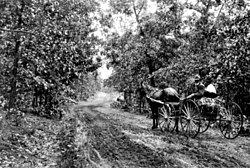. . . Experience has shown that our earth roads can, in general, be very much improved by proper construction and systematic maintenance at a cost well within the reach of almost any community. Furthermore, these improved earth roads serve as the best possible foundation for further improvements with a hard surface as means become available. . . .[1]

Post road in Lauderdale County, Alabama. Small hump in distance is chert which will be cut and used for surfacing.
The concept of stage construction, enunciated by Page in the above quotation, became one of the guiding principles of Federal road policy for the next 50 years.
During 1908, 1909 and 1910, the OPR supervised the construction of 1,300 miles of earth roads and 440 miles of sand-clay roads.[N 1] Inevitably, object lesson roads to demonstrate the use of local materials became, in some respects, experimental roads as well. The OPR’s Road Expert, W. L. Spoon, who was handling the object lesson road work in the southern States, thought that clay might be made into a suitable road surfacing material by burning or roasting it in place on the road. A small experimental project was set up the summer of 1904 near Clarksdale, Mississippi, in which 300 feet of clay “gumbo” road was burned by wood and bark fires until the clay was nonplastic. The resulting surface compared favorably to gravel and cost only one-fourth as much.[3]
The OPR also cooperated in the construction of experimental sand-clay roads in Iowa, Kansas and Nebraska to determine whether sand-clay was suitable for areas with cold climates and deep frost penetration.

Sand-clay road in San Patricio County, Texas. Smoothing with road drag after rain. No roller available and the road is not yet thoroughly compacted by traffic.
Experimental Roads Expand Knowledge of Roadbuilding
These experiments were not the first in which the Office had been involved. In 1898, the Office of Public Road Inquiries had built short steel trackway roads at the Trans-Mississippi Exposition at Omaha and at Ames, Iowa, and St. Anthony Park, Minnesota. These
66

